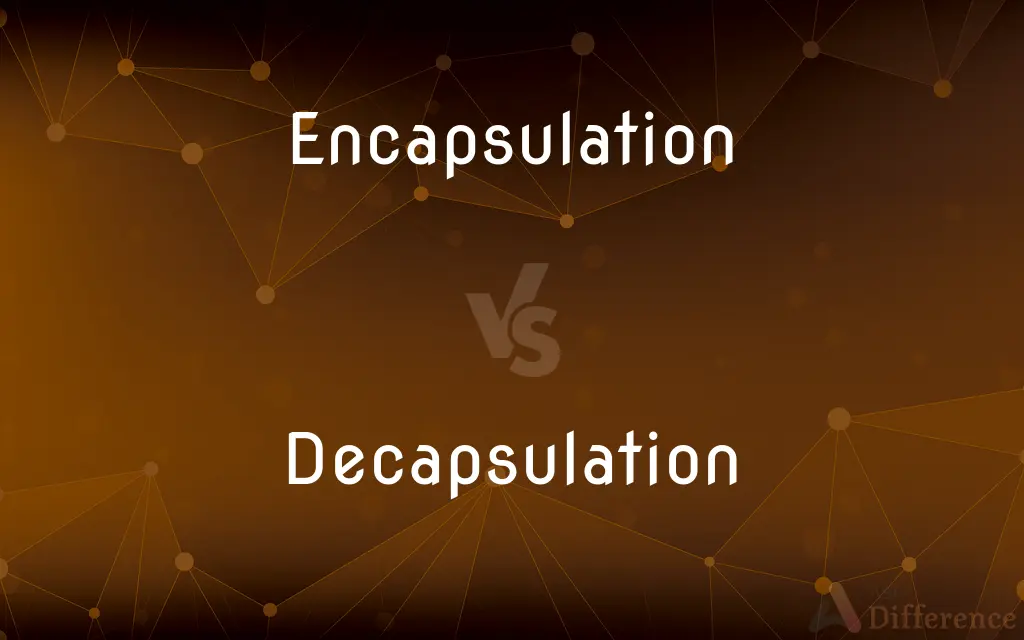Encapsulation vs. Decapsulation — What's the Difference?
Edited by Tayyaba Rehman — By Maham Liaqat — Updated on March 20, 2024
Encapsulation involves wrapping data and methods into a single unit, like a class, whereas decapsulation involves extracting this data from the unit.

Difference Between Encapsulation and Decapsulation
Table of Contents
ADVERTISEMENT
Key Differences
Encapsulation is a fundamental concept in object-oriented programming where data (attributes) and code (methods) are bundled together into a single unit, typically a class. This approach helps in data hiding as it restricts direct access to some of an object's components, enhancing security and ease of use. On the other hand, decapsulation refers to the process of accessing encapsulated data, essentially 'unwrapping' it. This can be done through methods like getters and setters in programming, allowing controlled access to the data.
In encapsulation, data is not exposed directly; instead, the class provides public methods to interact with the private data. This ensures that objects remain in control of their own data, with changes only possible through a controlled interface. Decapsulation, whereas, breaks this principle to some extent by providing mechanisms to access or modify data directly, which can be necessary for certain operations but risks compromising data integrity.
Encapsulation promotes modularity and maintenance of code by keeping a class's internal workings private, and only exposing a public interface. This means that changes to the encapsulated code can often be made without affecting other parts of the program. Decapsulation, in contrast, may expose internal details of a class, making the code more fragile and susceptible to errors as external entities can change the internal state unexpectedly.
One of the primary benefits of encapsulation is the ability to change internal implementation without affecting other parts of the program that use the class. This encapsulation principle supports the concept of information hiding, a key aspect of software engineering. Decapsulation, on the other hand, might be used in debugging or when interfacing with legacy systems, where direct access to object internals is necessary, though it should be approached with caution.
Encapsulation enhances the reusability of components by defining a clear and simple interface and hiding the complexity within. It allows developers to work with higher-level abstractions without worrying about the details. Decapsulation, however, by exposing those details, can sometimes undermine this benefit and should be used judiciously to avoid breaking the encapsulation.
ADVERTISEMENT
Comparison Chart
Definition
Bundling data and methods into a unit.
Extracting data from an encapsulated unit.
Purpose
To protect and hide data.
To access or modify encapsulated data.
Access Control
Typically uses private and public access modifiers.
May bypass access controls to reach data.
Impact on Integrity
Maintains high integrity and security.
Can compromise data integrity.
Use Cases
Designing classes and components in OOP.
Debugging or interfacing with legacy systems.
Compare with Definitions
Encapsulation
Encapsulation bundles data with the methods that operate on that data.
A class in Java encapsulates its fields and methods.
Decapsulation
Decapsulation can be used for debugging to inspect object states.
A debugger might decapsulate objects to show their current state.
Encapsulation
Encapsulation hides the internal state of objects.
A bank account object hides its balance from direct access.
Decapsulation
Decapsulation might be required when interfacing with legacy code.
Accessing old, encapsulated data formats for migration.
Encapsulation
Encapsulation enables data abstraction by exposing only necessary details.
A car object exposes methods like drive and stop, but not its internal mechanics.
Decapsulation
Decapsulation involves accessing hidden information from an encapsulated entity.
Using reflection in Java to access private fields of a class.
Encapsulation
Encapsulation strengthens security through data hiding.
A user object might hide its password field, making it inaccessible directly.
Decapsulation
Decapsulation, while useful, can risk data integrity.
Modifying an object's internal state without using its public API.
Encapsulation
Encapsulation supports modularity in programming.
A module encapsulating its functionality allows for easy updates without affecting other parts.
Decapsulation
Decapsulation can breach the principles of encapsulation for specific needs.
Accessing a private method for a critical patch.
Encapsulation
To encase in or as if in a capsule.
Decapsulation
The act or process of decapsulating.
Encapsulation
To express in a brief summary; epitomize
Headlines that encapsulate the news.
Encapsulation
To become encapsulated.
Encapsulation
The act of enclosing in a capsule; the growth of a membrane around (any part) so as to enclose it in a capsule.
Encapsulation
Grouping together an object’s ‘state’ (its data) and the operations that may alter or interrogate it (its methods).
Encapsulation
(networking) The process of arranging data into packets that can be transmitted using a given protocol.
Encapsulation
The act of inclosing in a capsule; the growth of a membrane around (any part) so as to inclose it in a capsule.
Encapsulation
The condition of being enclosed (as in a capsule);
The encapsulation of tendons in membranous sheaths
Encapsulation
The process of enclosing (as in a capsule)
Common Curiosities
Why is encapsulation important?
Encapsulation is important because it enforces modularity, increases code maintainability, and prevents unauthorized access to data, ensuring higher data security.
What does decapsulation mean?
Decapsulation refers to the process of accessing or extracting the data encapsulated within a unit, potentially bypassing the intended access controls.
What is encapsulation in programming?
Encapsulation is the bundling of data and methods that operate on the data within a single unit, like a class, to protect the data and keep it hidden from the outside world.
Can decapsulation compromise data integrity?
Yes, decapsulation can compromise data integrity by allowing unauthorized access or modification of encapsulated data.
How do encapsulation and decapsulation relate to each other?
Encapsulation is about creating a secure and modular unit by hiding data, whereas decapsulation involves breaking into that unit to access or modify the data.
Is decapsulation always a bad practice?
Not always; decapsulation can be necessary for debugging, testing, or interfacing with legacy systems, but it should be done carefully to avoid compromising data integrity.
Are there programming languages that do not support encapsulation?
Most modern programming languages support encapsulation, but the extent and mechanisms can vary. Some low-level languages might offer limited support.
Can encapsulation lead to over-engineering?
Overuse of encapsulation can lead to over-engineering if the additional complexity does not provide proportional benefits in security, modularity, or maintainability.
How does encapsulation enhance security?
Encapsulation enhances security by hiding the internal state of objects and only allowing controlled access through defined interfaces.
Can encapsulation affect the performance of a program?
While encapsulation adds a layer of abstraction, its impact on performance is generally minimal compared to its benefits in maintainability and security.
How do getters and setters relate to encapsulation and decapsulation?
Getters and setters are methods used in encapsulation to provide controlled access (decapsulation) to the private data of a class.
Can encapsulation be applied to non-object-oriented languages?
Yes, encapsulation concepts can be applied in procedural languages through modules and namespaces that hide internal implementation details.
Is it possible to have complete decapsulation?
Complete decapsulation, where all internal data of an object is freely accessible, is possible but goes against the principles of encapsulation and is generally discouraged.
How do you achieve encapsulation in object-oriented programming?
In object-oriented programming, encapsulation is achieved by defining classes that contain private data and public methods to access and modify that data.
What is an example of decapsulation in real-world scenarios?
A real-world example of decapsulation could be using special tools to access the internals of a sealed electronic device for repair or modification.
Share Your Discovery

Previous Comparison
Honesty vs. Truthfulness
Next Comparison
Unvested vs. VestedAuthor Spotlight
Written by
Maham LiaqatEdited by
Tayyaba RehmanTayyaba Rehman is a distinguished writer, currently serving as a primary contributor to askdifference.com. As a researcher in semantics and etymology, Tayyaba's passion for the complexity of languages and their distinctions has found a perfect home on the platform. Tayyaba delves into the intricacies of language, distinguishing between commonly confused words and phrases, thereby providing clarity for readers worldwide.















































